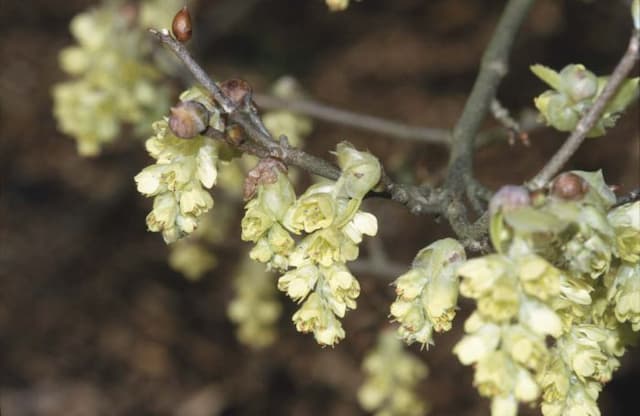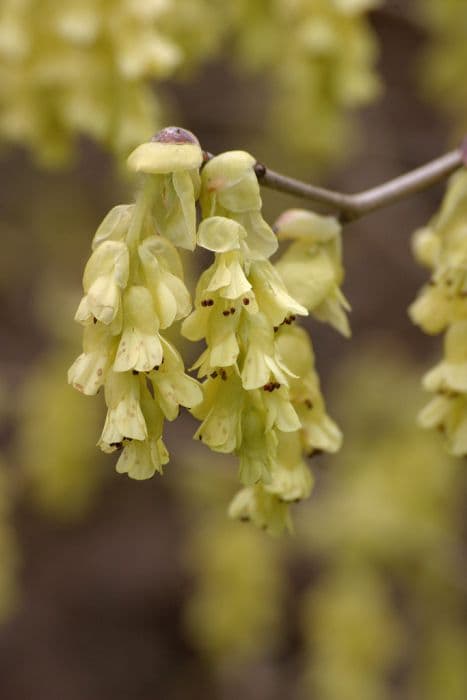Sycoparrotia × Sycoparrotia semidecidua

ABOUT
× Sycoparrotia semidecidua, also known as the Parrotia-Persian Ironwood hybrid, is a hybrid plant that boasts a mingling of features from its parent species. It's characterized by its semi-deciduous nature, meaning it doesn't fully shed its leaves in the fall, retaining some foliage throughout the winter. The leaves of this hybrid are typically lush and may display a wide array of colors throughout the seasons. Starting as fresh green in spring, they can transition to bring a mixture of yellow, orange, red, and sometimes even purple hues in the autumn, offering a striking visual display. The branching structure of this plant can be described as intricate, with limbs that can spread out elegantly from the main trunk, creating an attractive silhouette against the winter sky when some of the leaves have fallen. The branches grow in a pattern that provides visual interest throughout the year. The bark of this hybrid contributes to its ornamental value. It can exhibit a smooth texture and peeling nature, revealing multiple layers that may include shades of gray, brown, and cream. This exfoliating bark adds another level of interest, especially during the colder months when the foliage is sparse. During the blooming season, this plant may produce inconspicuous flowers that are often overshadowed by the boldness of the foliage. Nevertheless, these flowers can still appeal to local pollinators and contribute to the hybrid's uniqueness. Overall, the Parrotia-Persian Ironwood hybrid is recognized for its seasonal color changes, the intricacy of its branching, and the textural and chromatic qualities of its bark, making it a distinguished and attractive addition to landscapes where it can flourish without the constraint of its actual size being a factor.
About this plant
 Names
NamesFamily
Hamamelidaceae.
Synonyms
Sycoparrotia, Hybrid Parrotia-Persian Ironwood.
Common names
× Sycoparrotia semidecidua.
 Toxicity
ToxicityTo humans
There is limited specific information available regarding the toxicity of the hybrid Parrotia-Persian ironwood (× Sycoparrotia semidecidua) to humans. This hybrid plant isn't commonly known for being toxic, but it is always advisable to exercise caution with unknown plants. Generally, Persian ironwood in itself is not listed as a toxic plant to humans, and due to the lack of documented cases or studies on the hybrid's toxicity, it is not conclusively known whether × Sycoparrotia semidecidua could produce adverse effects if parts of the plant were ingested. If any part of the plant were improperly consumed, watch for any unusual symptoms and consult a medical professional.
To pets
Similar to humans, there is little specific information regarding the toxicity of Parrotia-Persian ironwood (× Sycoparrotia semidecidua) to pets. As a hybrid of species that are not commonly associated with toxicity, such as Persian ironwood, it is not well-documented as a poisonous plant to pets. Thus, there are no specific symptoms of poisoning associated with this plant that have been widely reported. However, as with any plant that is not typically part of an animal's diet, caution should be taken to prevent pets from ingesting it, and if ingestion occurs, monitoring for any signs of distress and consultation with a veterinarian is advised.
 Characteristics
CharacteristicsLife cycle
Perennials
Foliage type
Semi-deciduous
Color of leaves
Varies
Height
6-8 feet (1.8-2.4 meters)
Spread
6-8 feet (1.8-2.4 meters)
Plant type
Shrub
Hardiness zones
5
Native area
Hybrid
Benefits
 General Benefits
General Benefits- Ornamental Value: Adds aesthetic beauty to landscapes with its hybrid vigor and unique foliage.
- Adaptability: Tolerates a range of soil types, making it versatile for different garden settings.
- Drought Resistance: Once established, it can withstand periods of low water availability.
- Seasonal Interest: Provides visual interest throughout multiple seasons with changing leaf colors and textures.
- Low Maintenance: Requires minimal upkeep once established, suitable for gardeners of all skill levels.
- Wildlife Habitat: Attracts birds and beneficial insects, supporting local biodiversity.
- Erosion Control: Helps stabilize soil and prevent erosion with its root system.
- Shade Provider: Offers shade during hot summer months, creating cooler microclimates.
- Hybrid Growth: Exhibits increased vigor and resilience due to its hybrid nature.
 Medical Properties
Medical PropertiesThis plant is not used for medical purposes.
 Air-purifying Qualities
Air-purifying QualitiesThis plant is not specifically known for air purifying qualities.
 Other Uses
Other Uses- Sycoparrotia semidecidua can be used in woodworking to create ornamental objects or small wooden items, taking advantage of its hard, durable wood.
- The plant is sometimes included in educational botanical gardens or horticultural programs for its hybrid characteristics, demonstrating plant hybridization concepts.
- In landscape design, Sycoparrotia semidecidua is used for creating autumnal themes in gardens due to its attractive fall foliage.
- Photographers might use the plant as a backdrop during the fall season because of its aesthetic leaf coloration.
- Its dried leaves can be used in craft projects, such as creating natural leaf collages or as an inclusion in eco-friendly art pieces.
- Due to its dense canopy, the plant can serve as a privacy screen in residential landscapes, blocking unwanted views or creating private garden nooks.
- The branches of Sycoparrotia semidecidua can be used in floral arrangements, providing a rustic and woodsy element to the design.
- The tree can be planted as part of a wildlife garden to provide shelter for birds and small mammals within urban and suburban environments.
- The bark of the tree may be used in decorative bark mulch mixes, providing both a functional and aesthetic element to garden beds.
- Its unique hybrid status might make it a subject for artistic endeavors such as botanical drawing, painting, or even sculpture inspiration.
Interesting Facts
 Feng Shui
Feng ShuiThe Parrotia is not used in Feng Shui practice.
 Zodiac Sign Compitability
Zodiac Sign CompitabilityThe Parrotia is not used in astrology practice.
 Plant Symbolism
Plant Symbolism- Adaptability: × Sycoparrotia semidecidua, with its hybrid vigor, signifies adaptability and resilience, able to thrive in diverse conditions.
- Transition: As a semideciduous plant, it represents change and the transition between states, reflecting life's constant evolution.
- Integration: The plant's hybrid nature stands for integration and unity between different elements or ideas.
- Endurance: Its ability to withstand varying climates symbolizes endurance and the capacity to persist through challenges.
 Water
WaterThe Parrotia-parent hybrid, commonly known as the Ironwood Parrotia, prefers to be watered deeply once the top inch of the soil feels dry to the touch, generally every 7 to 10 days, depending on climate conditions. During the growing season in spring and summer, the water requirement may increase, and it can be beneficial to provide about 1 to 1.5 gallons of water to thoroughly saturate the root zone. In the fall and winter, reduce watering to when the top few inches of soil are dry. Always check the soil moisture level before watering to avoid overwatering, which could lead to root rot.
 Light
LightThe Ironwood Parrotia thrives in full sunlight to partial shade. It is best to position the plant where it can receive at least four to six hours of direct sunlight daily, which promotes healthy growth and vibrant foliage. While it can tolerate some shade, too little light could result in less vigorous growth and sparse flowering.
 Temperature
TemperatureThe Ironwood Parrotia can tolerate a range of temperatures and is hardy to between -20 to -30 degrees Fahrenheit. The ideal temperature range for this hybrid is between 60 to 80 degrees Fahrenheit during the growing season. While the plant is quite hardy, it's important to protect it from extreme temperature fluctuations, especially during the tender new growth in the spring.
 Pruning
PruningPrune the Ironwood Parrotia in late winter or early spring before new growth begins. Pruning is essential to remove any dead or damaged branches, to shape the tree, and to maintain its health and attractive appearance. It's not necessary to prune the plant annually, but occasional thinning helps to ensure good air circulation and light penetration throughout the canopy.
 Cleaning
CleaningAs needed
 Soil
SoilThe Parrotia-Persian Silk Tree hybrid × Sycoparrotia semidecidua thrives best in fertile, well-draining soil with a slightly acidic to neutral pH, ideally between 6.0 and 7.0. A mix containing loam, compost, and a small amount of sand or perlite promotes healthy growth.
 Repotting
RepottingThe Parrotia-Persian Silk Tree hybrid, commonly called × Sycoparrotia semidecidua, generally requires repotting every 3-5 years. It should be repotted in the spring before the onset of new growth.
 Humidity & Misting
Humidity & MistingThe Parrotia-Persian Silk Tree hybrid, known commonly as × Sycoparrotia semidecidua, prefers moderate humidity levels, around 40-60%, to thrive.
 Suitable locations
Suitable locationsIndoor
Provide bright, indirect light and even moisture for × Sycoparrotia semidecidua.
Outdoor
Plant in partial shade to full sun and mulch for × Sycoparrotia semidecidua.
Hardiness zone
5-8 USDA
 Life cycle
Life cycleThe life of × Sycoparrotia semidecidua, commonly known as Parrotia, begins with seed germination, where the seeds require a period of cold stratification to break dormancy. After the stratified seeds are sown and germinate, the seedlings go through a juvenile phase where they develop a root system and foliage. As they transition to the vegetative stage, the young plants experience rapid growth and begin to form a defined stem structure and branching pattern. During the reproductive stage, mature Parrotia plants produce flowers, usually appearing in late winter to early spring, which upon pollination develop into fruit containing the seeds. These seeds are then dispersed, often by wind or animals, completing the reproductive cycle. As a perennial, Parrotia lives for many years, going through multiple reproductive cycles while gradually increasing in size and stature, until they eventually reach senescence and die.
 Propogation
PropogationPropogation time
Spring-Early Summer
The × Sycoparrotia semidecidua, commonly known as the hybrid Parrotia, is primarily propagated through softwood cuttings. This method involves taking cuttings from new growth of stems that are just beginning to mature but are not yet hard. The cuttings are typically taken in late spring or early summer when this softwood material is most readily available. It's crucial to select healthy, disease-free shoots and to make the cuttings approximately 4-6 inches (10-15 cm) long. The bottom end of the cutting should be dipped in rooting hormone to encourage root development and then placed in a well-draining growing medium. The environment should be kept humid with adequate sunlight and warmth, without direct sun exposure, to encourage the cuttings to root. Constant moisture and patience are key, as it may take several weeks for the roots to establish.









